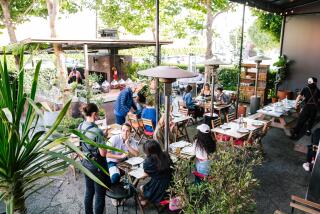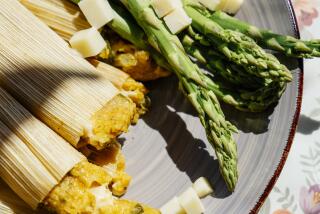Basking in Jerez, the Land of Sun and Sherry
- Share via
JEREZ DE LA FRONTERA, Spain — While the southern region of Andalusia is envied by other Spaniards as the home of “sherry, sun and beautiful women,” this town can lay almost exclusive claim to the first, with more than its fair share of the latter two.
Phoenicians first cultivated vineyards in the area called Xera 3,000 years ago. The Romans later named the area Ceret and the Moors Shiraz before the English finally got it back to Xeres in the 17th Century.
Whatever the word’s history, jerez (hair-ith) is what you ask for in a Spanish bodega , or restaurant, if you wish to start your meal in a civilized fashion.
Almost as important as sherry to most Jerezanos is their longstanding love and understanding of horses, particularly the distinctive Spanish horse developed from Arab stock by monks here. This magnificent animal was taken by a Hapsburg emperor to Austria in the 16th Century to become the elegant Lippizaners performing in Vienna’s Spanish Riding School.
Jerez also is, historically, Moorish-Gypsy country, given to yet one more great love--the flamenco dance with its wailing African music, staccato rhythms, swirling ruffles and castanets.
The town has broad avenues lined with orange trees, small plazas, a maze of narrow but neat alleyways in the old section and a profusion of small cafes and bars where you may nibble on tapas . . . with a glass of sherry, of course.
To here: Fly Iberia direct to Madrid or take American and TWA with stops. Spain’s Aviaco flies Madrid-Jerez in an hour.
How long/how much? Give Jerez two days, perhaps another for sojourns to the “white town” of Arcos de la Frontera, or to the old ports of Cadiz and Puerto de Santa Maria 22 miles away on the Mediterranean coast. Accommodations in town are moderate, while dining can be expensive.
A few fast facts: Spain’s peseta recently traded at .0087, or 114 to the dollar. Winters are mild, summers moderately hot, with an agreeable humidity level that all adds up to the perfect climate for making sherry. Walk the old section of town where parking is a problem.
Settling in: Hotel Avenida (Avenida Alvaro Domecq 10; $57 to $68 double) has a great location near many city sights. This modern place has a cool marble lobby with black leather furnishings and handsome rugs. Bedrooms are contemporary, with most big-hotel amenities. Take breakfast and snacks in a bright and cheerful room.
Hotel Residencia Avila (Calle Avila 3; $35-$40 double) is on a quiet street in the old section, a small place with bar and breakfast room (the only meal served) just off the lobby. Bedrooms are simple but pleasant, baths fine.
Royal Sherry Park (Avenida Alvaro Domecq 11; $90-$100), in a park across from Hotel Avenida, is spread out in resort fashion, with handsome grounds, a pool and a feeling of seclusion. Bedrooms are contemporary, with TV, mini-bar and balconies. There’s dining inside or on the terrace in summer.
Regional food and drink: Jerez and the province of Cadiz have the most varied cuisine in Andalusia, much of it based on marvelous seafood and the renowned Jabugo ham. Rinones al jerez (kidneys sauteed in pan juices and sherry) are a favorite.
Ajo caliente is a hearty hot garlic soup, but our favorite is the summertime ajo blanco , a chilled white soup made with garlic, almonds and olive oil; a few white grapes are added to give it flair. Pescaito frito , or fritura gaditana , will bring you the deep-fried mixed fish of Andalusia’s Mediterranean coast.
Discussions of sherry can be endless, but here are the four major types: fino is dry, light in color and character, perfect with entremeses (hors d’oeuvre); manzanilla is very dry, almost tart, with a bouquet and taste of ripe apples; amontillado has a golden color and fuller body, and an aftertaste of hazelnuts to savor with your almonds and olives; oloroso has a full body, heady aroma, golden-red color, and is best for after a meal.
Good dining: Tendido 6 (Calle Cizco 10) is opposite the bullring, which accounts for its “Row 6” name. Owner Juan de la Flor knows every torero of the last several decades, and his restaurant is a wonderful study in rustic Andalusian style. There are lovely tiles and ironwork, and fresh carnations at every turn. Beautiful beams grace the tapas bar and dining rooms; the main dining area is a patio open to the sky in summer.
Choose from 20 fino sherries to start, then perhaps a tortilla de gambas , a Spanish omelet with shrimp. Then from a gigantic Chateaubriand for $13, partridge, loin of pork Andalusian style or several sturdy main courses. There’s a fine selection of Rioja wines.
El Bosque (Avenida Alvaro Dome 26) is considered Jerez’s finest by many locals, a gorgeous place filled with original regional paintings. But the fantastic food is the lure.
We had entremeses of quail eggs, garlic olives and miniature chorizo sausages with our finos . Then it was on to cream of mussel soup and a salad of cold shellfish and salmon.
Next came partridge wrapped in cabbage and braised in a sauce of tomatoes and peppers, then a cola de toro (bull’s tail) braised in a rich sauce of vegetables, herbs and sausage.
Bar-Restaurant Paco (Calle Arcos 33) is the place to get your budget back in line. Have a few tapas in the bar at the entrance. Serrano hams hang from the ceiling. Then move into the dining room and select three courses from the huge menu for $6, bread and wine included.
On your own: Your first stop should be the arena of La Real Escuela Andaluza del Arte Ecuestre, Spain’s royal riding school, where there are morning practice sessions and a weekly formal show, the latter a beautiful equestrian ballet and classical dressage with Spanish music and costumes from the 17th Century. La Feria del Caballo (horse fair, May 1-15) is the yearly highlight of Jerez’s social calendar.
Check to see if there is a performance at the Andalusian Flamenco Foundation, or visit the Pemartin Palace to view flamenco paintings, clothing, photos and artifacts.
Jerez and surroundings are awash in sherry bodegas , storing houses where the wine is aged and blended. Domecq, Harveys, Sandeman and other major vintners offer tours during which you’ll be briefed on the blending process and taste the various types of sherry.
Jerez is also a good place to start a tour of Los Pueblos Blancos, the white towns of Andalusia. Most of these towns predate the Moorish occupation from 711 to 1492, yet Muslim architecture and handicrafts left their marks on each. If the high-rise and tacky tourism of today’s Costa del Sol leave you dispirited, move a bit inland to Los Pueblos Blancos to experience the Spain of old.
For more information: Call the National Tourist Office of Spain at (213) 658-7188, or write 8383 Wilshire Blvd., Suite 960, Beverly Hills 90211 for a brochure on the province of Cadiz, including Jerez, with map, plus another map of Spain.
More to Read
Sign up for The Wild
We’ll help you find the best places to hike, bike and run, as well as the perfect silent spots for meditation and yoga.
You may occasionally receive promotional content from the Los Angeles Times.






